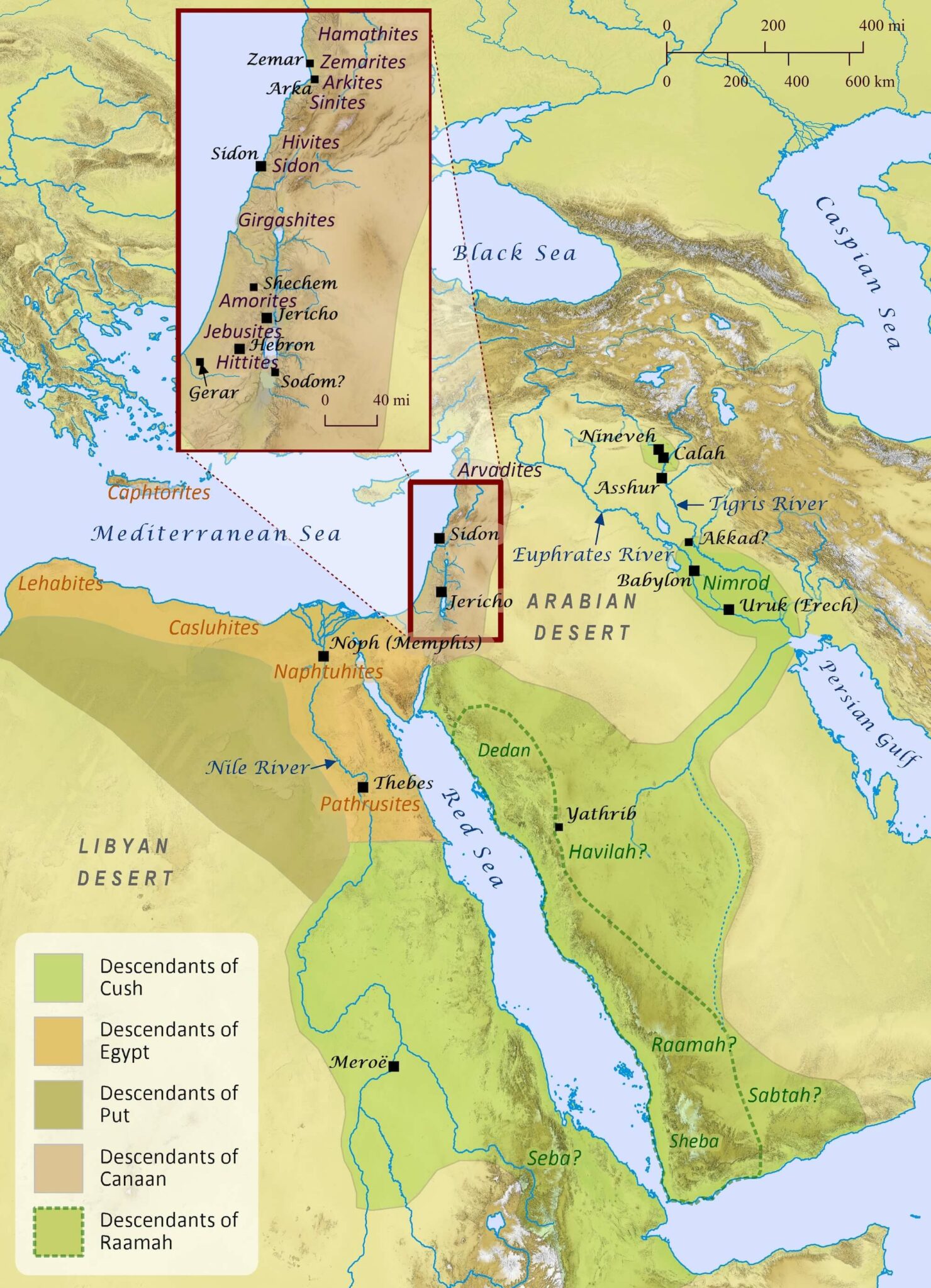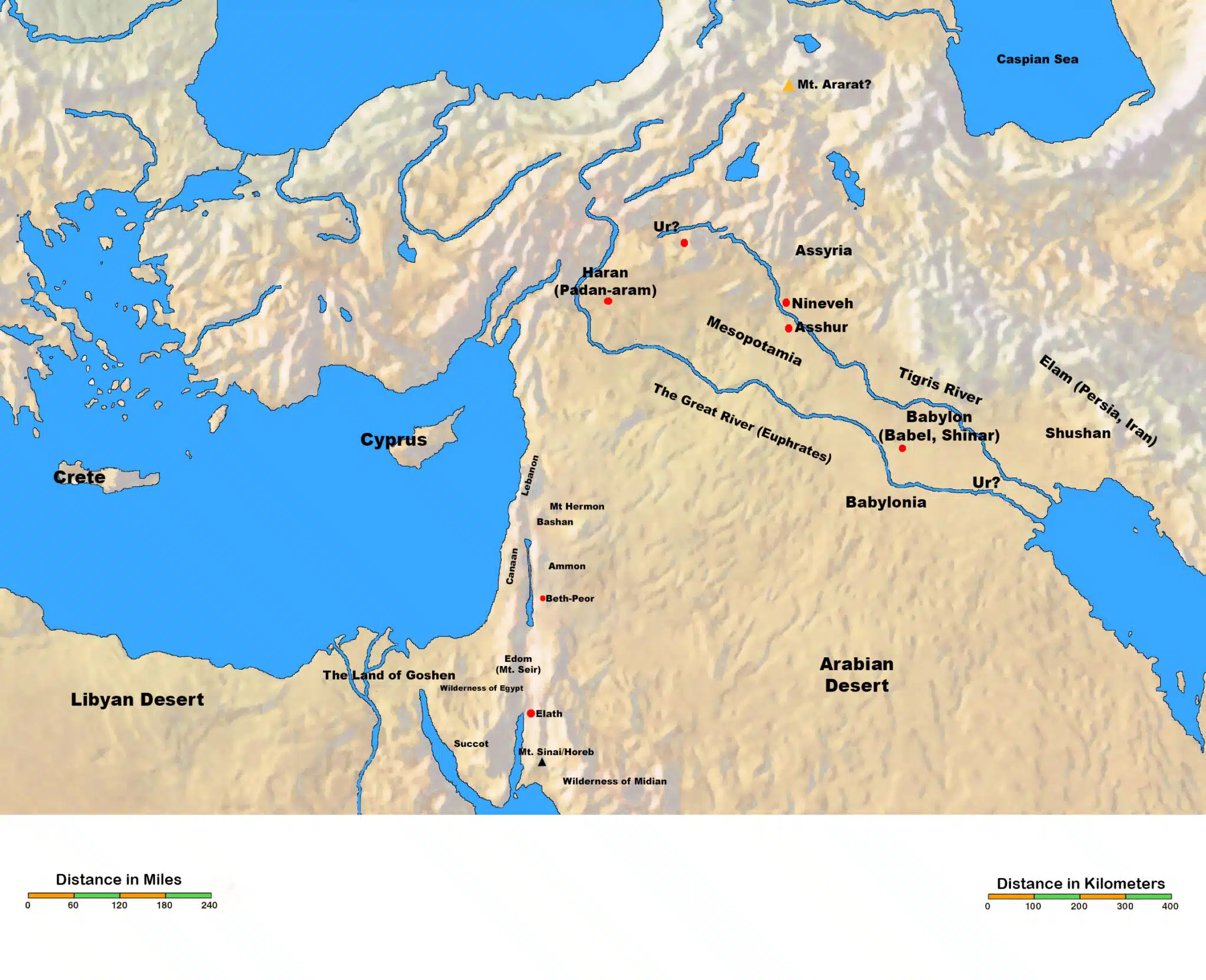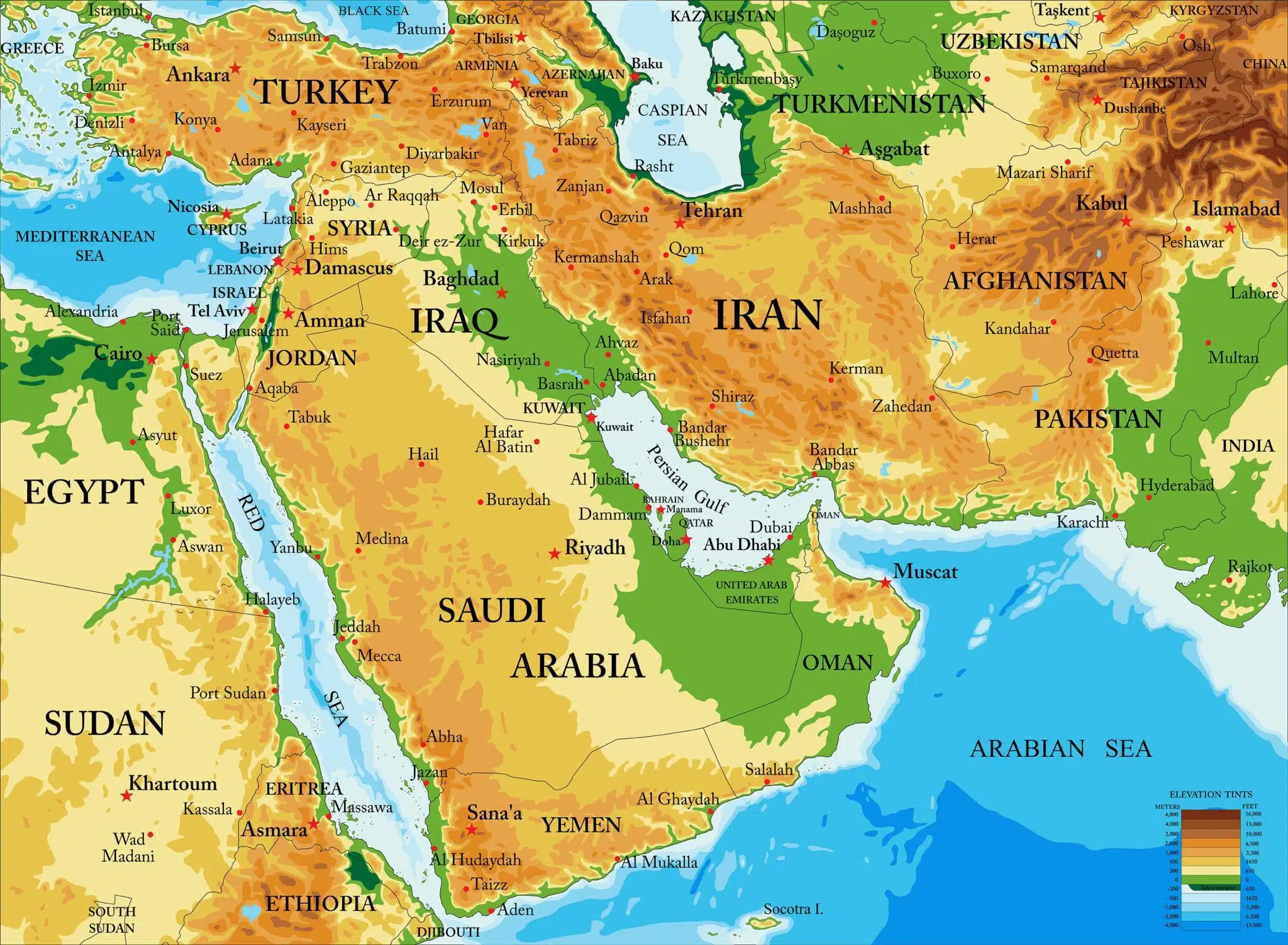Canaan was the father of eleven sons. The land of the Canaanites was called Canaan which later was conquered by the Jews. Ham had a total of 30 descendants.
Canaan represents the majority of Ham’s descendants. Canaan became the father of Sidon, his firstborn, and Heth and the Jebusite and the Amorite and the Girgashite and the Hivite and the Arkite and the Sinite and the Arvadite and the Zemarite and the Hamathite; and afterward the families of the Canaanite were spread abroad. He had eleven sons:
Sidon was the oldest son of Canaan. He settled in a famous port city in Phoenicia, north of Canaan. His descendants became known as the Phoenicians (Deuteronomy 3:9; Joshua 13:4,6). The Egyptian inscriptions that record the campaigns of Thutmose III (ca. 1490–1436 B.C.) in Canaan and Syria also mention Sidon, but not Tyre. The annals of Tiglath-pileser I (1109–1088 B.C.), who conducted military expeditions to Syria and Phoenicia also mention Sidon. The city of Sidon lies halfway between Tyre and Beirut.
Heth a son of Canaan, settled in Syria. His people became the Hittites. The Hittites lived in a coalition of cities within Canaan. The Hittites must be distinguished from the great empire whose capital, Hattusas, was in Turkey. The “land of the Hittites” and “the kings of the Hittites” refer to certain Syrian kings who once belonged to the Hittite empire in Asia Minor. However, in the OT “Hittites” usually refers to some of the pre-Israelite inhabitants of the hill country of Canaan in the days of the patriarchs. After the Hittite empire collapsed ca. 1200 B.C. and the city-states of Syria became independent, they continued to call themselves Hittite for several centuries. Assyrian and Babylonian records regularly used “Ḫatti-land” to refer to the whole of Syria and Palestine. According to Ezekiel, the city of Jerusalem owed its existence to the Amorites and Hittites (Ezekiel 16:3). The cave of Machpelah purchased from Ephron the Hittite is the family tomb of the patriarchs (Genesis 23:3, 25:10, 49:29–32, 50:13).
Jebus or Jebusite was a son of Canaan. He founded the city of Jebus better known as ancient Jerusalem (Judges 19:10-11; 1 Chronicles 11:4-5). The Jebusites lived in the hill country with the Amorites (Numbers 13:29). During the conquest of the land of Canaan, Judah was unable to drive them out of Jerusalem their major city (Joshua 15:63; Judges 1:8,21). The city remained Jebusite and independent of Israel through the era of judges and into King David’s early monarchy circa.1000 B.C. (Judges 19:11). David was determined to make Jerusalem his capital because of its central and strategic location. He was able to acquire the city without destruction (2 Samuel 5:6-9). King David purchased land from a Jebusite that Solomon would use to build the temple (2 Samuel 24:16; 1 Chronicles 21:15). The Jebusites continued to live in Israel until post-exile times (2 Chronicles 8:7; Ezra 9:1; Nehemiah 9:8).
The Amorite was another group of pre-Israelite dwellers in Canaan. They lived in the mountains of Palestine in Canaan. They were the people who lived in Canaan when Abraham moved there. Abraham enjoyed a peaceful coexistence with the Amorites, who joined him in defeating a coalition of eastern kings (Genesis 14:5–7,13). The Amurru, their Akkadian name, was a West Semitic people that first appeared in Babylonia about 2000 B.C. having migrated from the Syrian desert. Interestingly, in the fourteenth and thirteenth centuries B.C., cuneiform texts refer to a state north of Canaan called Amurru. The famous cities and dynasties of Babylon and Asshur were of Amorite descent.
Girgashites lived in Canaan or possibly from “land of Karkisha” in Asia Minor, mentioned among the allies of the Hittites in the inscriptions of Ramses II about the battle of Kadesh (Deuteronomy 7:1; Joshua 3:10, 24:11; Nehemiah 9:8).
Verses 17-18 refer to five Syrian Cities, four on the coast and one inland.
Hivite lived in Canaan, Lebanon (Judges 3:3), Gibeon (Joshua 9:1-7), and near Mount Hermon (Joshua 11:3; 2 Samuel 24:7) as well as Transjordan (Genesis 36:2). Israel would conquer their land (Exodus 3:8; Deuteronomy 7:1).
Arkite lived on the Lebanon coast. The city of Arka or Arqa, about 13 miles northeast of Tripoli, Lebanon, is mentioned in Egyptian texts as early as the twentieth century B.C. It is mentioned in various oriental sources of the second and first millennia. It was called by the Romans “Caesarea Libani.”
Sinite whose descendants are the Chinese. The Sinites moved very far east and, because of the separation of the mountains and deserts, developed their own culture. China is one of the few countries on earth that can trace a history of more than five thousand years.
Arvad or Arvadite was the most northerly of the important Phoenician cities. Present day Ruad, built on a rocky island about 50 miles north of Byblos off the north Phoenician coast. It is frequently mentioned in Assyrian records. The most northern Phoenician city was a famous and flourishing center in the second and first millennia B.C. (Ezekiel 27:8,11).
Zemarite settled in Sumra on the Phoenician coast. Zemar lies on the Mediterranean coast of Syria midway between Arvad to its north and Tripoli to its south. Tiglath-Pileser I locates it three double-hours south of Arvad. It is mentioned in Egyptian, Amarna, and Assyrian texts.
Hamath or Hamathite inhabited Hamath (modern Hama) in northern Canaan. Here many hieroglyphic inscriptions regarded as records of the Hittites or people of Heth have been found. His descendants also lived Phoenician cities. This ancient Syrian city, Hamath, lies inland on the middle Orontes River alongside one of the major trade routes, about 50 miles east-northeast of Arvad. A city has been on this site since about 4000 B.C. It marked the northernmost boundary of the land of Canaan (Numbers 34:8; Joshua 13:5) and was the northern marker for the realm of David and Solomon (2 Samuel 8:9-10; 2 Chronicles 8:4) and the state of Israel under Jeroboam II (1 Kings 8:65; 2 Kings 14:25–28).
The focus here is not on Canaan as a person, but as a location (Palestine). The boundaries of Canaan are noted. The territory of the Canaanite extended from Sidon as you go toward Gerar, as far as Gaza; as you go toward Sodom and Gomorrah and Admah and Zeboiim, as far as Lasha. The description of Canaan’s territories starts with Sidon (the extreme northern limit) to Gaza (the southwest limit) which sits on the main north-south highway, connecting Egypt and the Fertile Crescent along the Mediterranean coast (Deuteronomy 2:23). The southeastern line runs through the southern region of the Dead Sea marked by the cities Sodom and Gomorrah and the lesser known Admah and Zeboiim (. Hosea 11:8) to “as far as Lasha.”
The description of Canaan given here corresponds to that of the Egyptian province of Canaan following the peace treaty between the Egyptian king Ramses II and the Hittite king Hattusilis III (ca. 1280 B.C.). The Egyptians gave up all control of northern Syria, which belonged to the Hittites, while southern Syria and Palestine remained under Egyptian control. This encompassed southern Syria, Phoenicia, and Palestine west of the Jordan River. Gerar an important royal city in western Negeb and was west or northwest of Beer-sheba in a region well-watered providing pastures for shepherds. It was possibly an ancient north-south seacoast highway (the Via Maris) extending from Sidon to Gerar and connecting Egypt to Mesopotamia. Gerar is identified with the mound of Tell Haror (Tell Abu Hureireh which is eleven miles southeast of Gaza), which lies on one of the major wadis, Wadi esh-Shariʾah, about 15 miles northwest of Beer-sheba.
Inscriptions of the Egyptian king Seti I from around 1300 B.C. refer to Gaza as “The Canaan.” It was the most influential city on the southern coast of Canaan, contrasting with Sidon on the northern coast. Later it became a major Philistine city and was the regional capital of the Egyptian province of Canaan. Gaza, the most southerly of the coastal cities, was strategically situated along the main highway and trade route that linked Mesopotamia and Egypt. Modern Gaza is 11 miles northwest of Gerar. Sodom and Gomorrah are cities on the border of the land south-east of the Dead Sea. These are the so-called “cities of the Plain,” that were destroyed because of their wickedness (Genesis 14:2; Deuteronomy 29:22). Admah and Zeboiim were destroyed with Sodom and Gomorrah to cleanse the land (Hosea 11:8). Their most likely location today is the area covered by the southern extension of the Dead Sea below the Lisan. That the Dead Sea and Jordan Valley mark the eastern boundary of Canaan is clear from Numbers 34:12. The area of these four cities (Sodom, Gomorrah, Admah, and Zeboiim), indicates the southeastern extremity of Canaan. Lasha or Laish was in the northern region of the dead sea the northeastern corner of Canaan. Traditionally Lasha has been identified with Callirrhoe, a site of hot springs near the eastern shore of the Dead Sea.
Here the genealogy of the Table of Nations is resumed, as the important departures of Babylon, Egypt, and Canaan are complete. It should be noted that the land of Canaan later became the homeland of the Jews. Interestingly, in Moses’ time, Egypt and Canaan were provinces of the same empire. These are the sons of Ham, according to their families, according to their languages, by their lands, by their nations.
Ham had a total of 30 descendants. Ham’s descendants were excluded from the blessing of Shem’s lineage (Genesis 9:20-28). There are three groups ethnically and geographically distinct (African, Arabian, and Mesopotamian) that are all included as Hamites. From very early times, the African and Asian shores of the Red Sea, particularly at its southern part, engaged trading and commerce. South Arabians crossed the Bab el-Mandeb as traders and colonists and greatly influenced the culture on the western side.
Biblical Text
15 Canaan became the father of Sidon, his firstborn, and Heth 16 and the Jebusite and the Amorite and the Girgashite 17 and the Hivite and the Arkite and the Sinite 18 and the Arvadite and the Zemarite and the Hamathite; and afterward the families of the Canaanite were spread abroad. 19 The territory of the Canaanite extended from Sidon as you go toward Gerar, as far as Gaza; as you go toward Sodom and Gomorrah and Admah and Zeboiim, as far as Lasha. 20 These are the sons of Ham, according to their families, according to their languages, by their lands, by their nations.
Check out our other commentaries:
-
Acts 5:12-16 meaning
The apostles continue to heal the Jewish people in the walkway of the temple, preaching that Jesus is the Christ. Crowds gather, even from the...... -
John 18:12-14 meaning
John tells us that following His submission to arrest in the Garden of Gethsemane, Jesus was brought to the house of Annas first. He informs...... -
Luke 16:10-12 meaning
Jesus continues His teaching about money. He tells His disciple the faithfulness principle. He who is faithful in a very little thing will be faithful...... -
Deuteronomy 22:9-12 meaning
Moses prohibited the mixture of seed, plow animals, and clothes....... -
Deuteronomy 24:8-9 meaning
The first topic related to the section generally flavored by the ninth commandment is concerned with leprosy. Moses encourages the Israelites to listen to the......





